By Alex Israel
Transportation experts discussed the potential future of the Upper West Side’s curbs during a forum on curbside optimization hosted by Community Board 7’s Transportation Committee. At least 60 people showed up to the forum on Tuesday night, hosted at St. Paul and St. Andrews Church (263 West 86 Street) in place of the committee’s monthly meeting.
“Please come with an open mind and with questions for the panelists,” read CB7’s promotional flyer, which also described the intended purpose of the event as “to discuss the different possible uses of curbside space.” The forum was scheduled after the transportation committee urged the city to stop providing free parking for private cars during a meeting in May, in response the New York State legislature’s passing of a congestion pricing proposal that will take effect no earlier than January 2021.
The full panel included Charles Komanoff, creator of the model used by New York State legislators to analyze congestion pricing and President Emeritus of Transportation Alternatives, a non-profit organization with a mission is to decrease automobile use; Ed Pincar, Manhattan Borough Commissioner for the NYC Department of Transportation (DOT); and Rachel Weinberger, Senior Fellow for Transportation at the Regional Plan Association, an independent non-profit organization that focuses on recommendations to improve the quality of life and economic competitiveness in the tri-state area.
Upper West Siders were eager to open up the floor without so much as an introduction from the speakers—but before turning to questions, committee co-chair Howard Yaruss invited the panelists to kick the night off with some opening remarks.
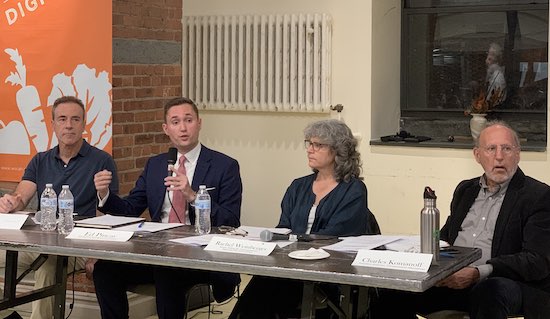
Weinberger started the discussion with a short introduction to the issue of curb management, which she identified as a “resource allocation problem” that involves competing demands for the curb.”The right allocation today might not be the right allocation ten years from now,” she said. “The allocation we have—there’s actually no reason to believe it’s in fact the right allocation for today. So we need to come up with a systemic and systematic approach to thinking about these issues,” she added, noting the complexity of the topic and praising the community board for hosting the discussion. “It’s a critical question and it’s not well-answered in any way I’m aware of.”
Pincar spoke next, emphasizing DOT’s dedication to taking a balanced approach to the problem. “Trying to find the right answer is really challenging,” he said, echoing Weinberger. “In the past it may have been unbalanced, and dedicated too much to one mode of transportation, and now we’re trying to bring it back to a situation where the many different people in our neighborhood—residents, businesses, institutions, bus riders—are trying to get the best available curb to them,” he said, pointing to the success of DOT’s more recent pedestrian enhancements, including shared streets, busways, street seats, and bike corrals.
Komanoff rounded out the opening remarks by voicing support for congestion pricing and paid curbside parking. Congestion pricing represents “the opening of a door or the turning of a page away from treating resources as boundless and—in a funny way—without value,” said Komanoff, who believes putting a price against these resources is the only way to change behaviors for the better. “When we win congestion pricing, we are going to turn to pricing curbside space. Not because we want to make life harder for New Yorkers, but because we want to make it easier,” he said to a mix of groans and cheers from the audience.
From there, Yaruss began to summarize the written questions for the panel that attendees had submitted via index card, ranging in topic from parking permits and curbside pricing to loading zones and bus and bike lanes.
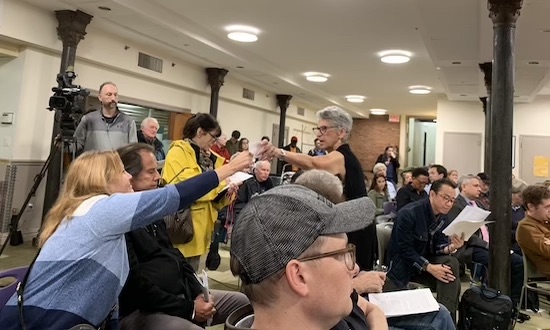
“Why is New York City the only city in the country that doesn’t have residential parking permits?” he read off an index card, laughing at the framing of the question. Residential parking permits (RPP), which designate certain street parking spaces for the exclusive use of local residents, are currently implemented in some form in San Francisco, Chicago, Boston, Washington D.C., and Portland, OR. New York politicians have considered them but they’ve never materialized.
“We have concerns about the system and how it would work in our city,” answered Pincar, referencing prior studies conducted by DOT. An overwhelming number of vehicles and a limited supply of curb space suggests that DOT wouldn’t be able to guarantee everyone a space, he said. But, as he attempted to assure the audience (for the first of many times throughout the night), there is no specific proposal up for discussion on either side of the issue—and the first formal study regarding residential permit parking won’t occur until at least 18 months after congestion pricing rolls out.
Weinberger jumped in to encourage residents to think about the bigger picture before deciding to support any future proposal. She rendered the concept of RPPs as potentially “shortsighted,” because, by “convert[ing] the public right of way for private use to the people who live in the area,” they prohibit non-locals from visiting and patronizing neighborhood businesses and institutions.
A white paper released by Manhattan Borough President Gale Brewer’s office studied other cities’ implementation of RPPs, concluding their success was a mixed bag, “with some cities left wondering if creating a permit parking program was the right choice in the first place.” Brewer ultimately takes a neutral stance, but warns of high price points and potential legal challenges as barriers to entry for implementing such a program in New York.
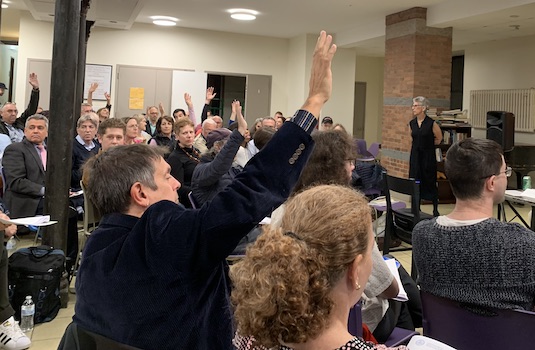
Yaruss then turned the discussion to potential pricing models. Weinberger, who believes the goals of such a program would need to be established before moving onto pricing, suggested monthly garage pricing is likely a reasonable comparison. Pincar categorized the topic as “political,” in that state legislators would likely have a large say in pricing, should a proposal for RPPs in New York come forward.
Next came the question of DOT’s process in determining curb usage. “Does DOT have values to allocate curb space?” Yaruss asked. “If so, what are they?”
Pincar listed safety as the top concern of DOT, who he said takes an “inch by inch approach” to allocating the curb, always trying “to strike the appropriate balance.” For example, DOT traditionally hasn’t allocated a lot of curb space for commercial vehicles, Pincar said, but with the growth of e-commerce, he wondered if that would be a sustainable policy moving forward. Weinberger noted that DOT’s balancing of the curbs might mean less space for private cars. “It’s a system, and it’s complicated,” she said.
When Yaruss followed up, asking whether or not loading zones would help free up space for these commercial vehicles, Komanoff suggested the city charge companies like Amazon and FreshDirect higher prices “to reflect congestion costs their presence is imposing on the community”—while Weinberger warned that those costs might end up getting passed onto the community.
The panelists also addressed concerns about how middle- and low-income car owners would be impacted by congestion pricing or an RPP. “By and large, the people for whom we have the greatest equity concerns are not car owners,” said Weinberger. She maintained that funds earned from the congestion pricing program will be invested in transit, “which is much more likely to serve people of limited income and lesser means.” Komanoff added that New Yorkers below the poverty line are less likely to commute regularly from outside the congestion zone into the congestion zone, and would benefit more from improved mass transit.
The discussion moved on to other uses for the curb beyond residential parking. Touting the success of the recent 14th Street busway pilot project championed by Speaker of the New York City Council Corey Johnson, Yaruss asked if DOT has a plan for implementing more solutions like this, despite some initial community board opposition.
“It’s very difficult to operate a transportation system when you have these neighborhood by neighborhood oppositions,” said Weinberger, acknowledging the tension between local neighborhoods and the city at large. Progress might not come quick enough for some, offered Pincar, but “intense engagement with the public leads to improved projects.”
Finally, the conversation turned to the environment. “Could you address how you would try to make the streets more livable?” asked Yaruss.
Pincar pointed to DOT’s ongoing push for innovation, and referenced a new study underway in FiDi that will evaluate the possibility of using “garbage corrals” in place of parking spots. For DOT, Pincar says striving for sustainability will all come back to the question: “Is this a better use of that curb?”
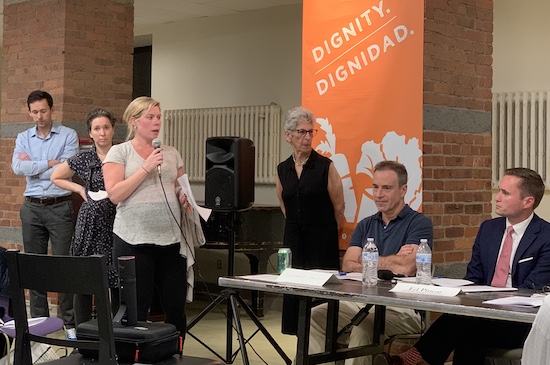
With some time remaining, Yaruss turned the floor over to the attendees for additional questions. Of the 16 people who took the mic only a few had clear questions that the panelists could address, and they had nearly all been covered at some point in earlier discussion.
As time ran out, for the rest of the attendees, the open mic was an opportunity to voice criticism of DOT and concerns about the concept of residential parking permits and curbside allocation that de-prioritized cars.
“We use our cars to escape New York,” said one, lamenting the idea that he might lose curb space for parking, where his car typically sits unused throughout the week. (“Is storing a vehicle the best use of the curb?” asked Weinberger in response.)
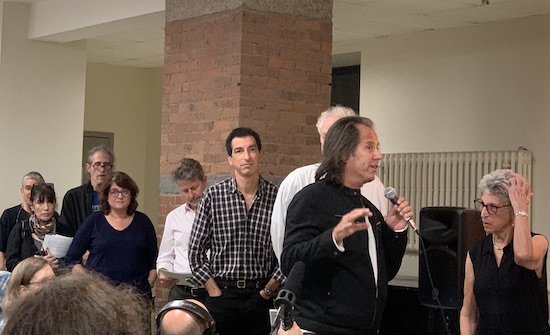
The line of speakers at the forum.
“Has anyone on the panel actually considered talking with anyone in the community about the use of cars, or is the whole thing an analytical exercise?” asked another, as he participated in a public forum to gauge community opinion. “I am an internationally recognized expert on curb management, and I was asked to come here tonight for questions,” said Weinberger, growing exasperated with the crowd.
Others disparaged DOT for their “improper management” of the curb (“I reject the premise,” responded Pincar), criticized hypothetical models for RPP pricing (“No price is set, because the proposal doesn’t exist,” reminded Pincar), and wondered why the forum, which had been listed on the CB7 website for a month, was “so poorly publicized”—among other concerns unrelated to the expertise of the panelists.
“How can I be part of the solution?” asked the last man to speak, who seemed genuinely interested in understanding the available actions he could take to reduce the negative impacts of parking his car in the city, while primarily using it for leisure. Komanoff directed him to look into forming a car sharing group—to eye rolls and groans from the crowd.
“We badly need innovation,” Komanoff said, as the forum wrapped up and Upper West Siders took to the streets.



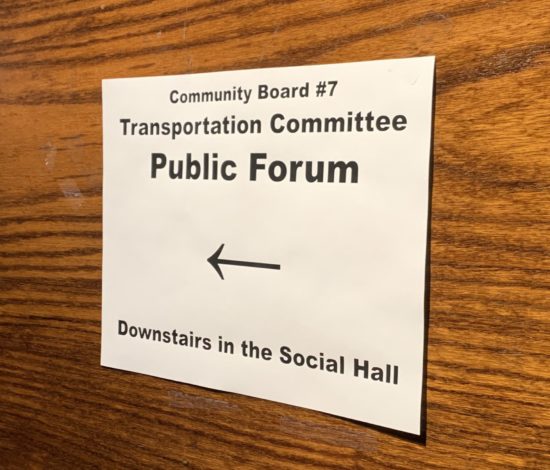



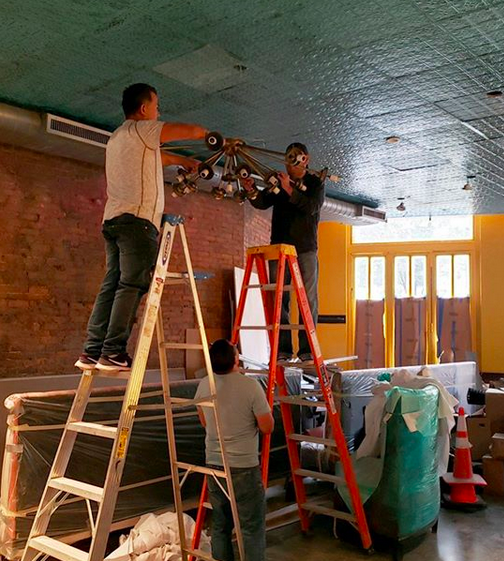

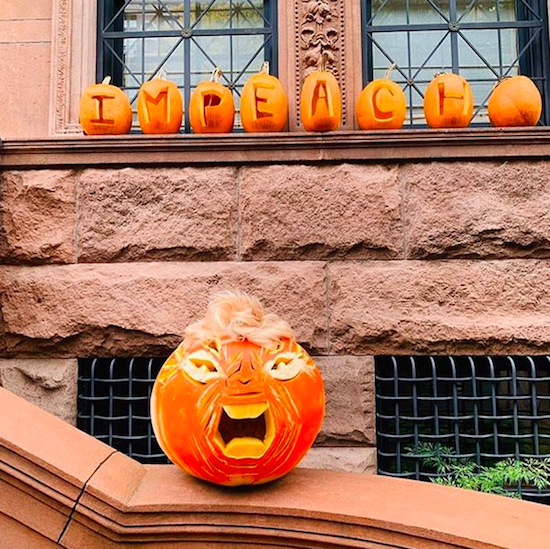
How about creating loading and unloading zones for Fresh Direct, Amazon, etc. and they are only allowed to stay for 30 minutes at a time, rather than being parked there all day like they do now. There are tons of empty store fronts so require them to unload their boxes into a storefront, rather than filling the streets with them.
Overall traffic flow would also be a lot more efficient if there was a law forbidding walking and using a mobile phone. People clutter up sidewalks because they are walking very slowly with their heads down. Similarly, car and bike traffic get slowed because people very slowly cross the street while texting, making it difficult for cars and bikes to turn. And don’t get me started on people on subway platforms and the stairways out of subway stations. Everyone must read their texts immediately or else!!!
One important point that belies belief is how is a forum considered impartial when the Chairman of the CB7 Transportation committee, Howard Yaruss is a sitting board member of Cyclists lobbying group, Transportation alternatives?
The Chairman is biased, one panelist was the founder of TA and DOT and the two experts from the city take their orders from De Blasio. There was not a single representative to give an alternative point of view. This is so indicative of the bubble that CB7 live in.
The biggest laugher was the idea of taking seating and turning it into “seating” where DOT plans to engage groups to “program” the space. As a couple of people said at the meeting, we live with two gerat parks on eotehr side of us, we don’t need that kind of space and if we want to see how that space is utilized we need only look to the Malls on Broadway or the pedestrian plaza in Tines Square to see who will utilize these spaces: The homeless, drug addicts, drunks Furries and other scammers.
We need congestion pricing extended throughout Manhattan and residential parking permits before another space is taken then traffic can be evaluated and zones for things like deliveries can possibly implemented.
You have to realize that as much as CB7 and their partners TA shroud everything in “safety” that is all a ruse as their ultimate goal is to rid NYC of cars. It’s time to stop them. While household ownership may be 30% many of those households have multiple voting adults in them and it is time we organized and stood up for our rights.
I knew people involved with TA in the 80s. It was a responsible group involved in advocacy and education.
Komanoff’s agenda (he writes on blogs) is clearly to rid the City of cars. he’s a bit like Wayne LaPierre in that he took TA from an education & awareness group to an absolute one the way LaPierre perverted the NRA.
Yay. Garbage corrals! Sidewalks for people and not for wet or snow covered bags of trash taking up walking space and that dogs have likely peed on. And maybe one day I can cross the street mid-block without having to squeeze between cars?
— “And maybe one day I can cross the street mid-block without having to squeeze between cars?”
Um, or maybe you could walk all the way to the corner and cross at the crosswalk, as the law requires?
I’m not sure I see why the City should make it easier for you to jay-walk willy-nilly, interrupting the flow of traffic (even the newly-sainted bicycles!) wherever and whenever the whim strikes you.
Excuse me but jaywalking is a NYC birthright!
So is parking on the street!
Cross at the street mid block? In other words break the law?
“Has anyone on the panel actually considered talking with anyone in the community about the use of cars, or is the whole thing an analytical exercise?” asked another, as he participated in a public forum to gauge community opinion
🔥🔥🔥🔥🔥🔥🔥
Mass transit is at capacity. I can not get into the first subway that usually pulls up during rush hour. I then pray I can squeeze into the next train. Buses can’t get you that far. If we make driving difficult, what do you think is going to happen? People are going to start moving out of the city since they can’t get to work. I’m not going to bike an hour to work each way. Politicians that don’t commute or have to show up on time for a job don’t have a clue. Make driving more difficult and see what happens to the already dropping housing market.
Congestion pricing will increase the traffic north of 61st street
No. It won’t.
Why would anyone drive all the way into the city and pay for parking above the congestion zone?
They will either pay the toll or they will find another way into the city (hopefully on mass transit).
They will drive around looking to park in neighborhoods above 61st now. They already do!!!
No. They don’t. At least it’s not a widespread practice.
You are probably seeing your neighbors circling around looking to find a different parking spot for street cleaning.
This is a totally obtuse review of this forum which was totally obtuse in itself. Endlessly ‘officials’ lobbied for their academic work on curb and parking usage. Hardly willing to hear community sentiment it finally burst forth with rage when time was running out. Community individuals made it clear that they want no interference with their accustomed cruising style of parking, they do not want spaces allowed for garbage nor for delivery trucks whose business moves along. Taxing these entities will come from users pockets. Building workers, hospital workers, health workers, teachers pore into our neighborhoods and need every consideration without fees to be a part of this community. With two grand parks nearby we do not need our curbs to be gardens or recreational spaces. Developers and construction sites have been totally bypassed as revenue sources for using our public parking spaces and no mention at all was made as to encouraging the garage business to play a role in accommodating a future increase in auto traffic co-operatively. the panel members were locked in their presentations and showed no regard to staunch agitated meaningful community sentiment. They were deaf to our serious concerns and more proud of applauding a 14 th street traffic change. Did they know where they were? were any of them from the neighborhood or living with cars. This is no place for judgment on who has or uses cars for what reason!
The meeting was listed as a community board meeting. The community was nearly disregarded despite the volume and agitation of their opinions!
Exactly right!!!!
We don’t need innovation. Simply put, if you remove curbside parking or restrict it, people will move out, not visit, and in turn further hurt an already fragile NYC economy.
Seems to me that CB7 should be more focused about the quality of life issues like crime, traffic congestion on Amsterdam due to bike lane implementation, and litter – seems to me that no one can find a trash can these days – not just figuratively among other blights that have only increased under the current administration.
Tired of CB7 “Community” board members being ineffectual and bending over backwards to make this neighborhood become more and more unlivable for the people living here and less and less attractive to businesses either existing or looking to move in. What business in their right mind would want to open on Amsterdam knowing that a Fresh Direct truck will be sitting in front of it all day long – be it a restaurant or otherwise.
I ran for a seat on CB7, but I guess I didn’t fit in with the “group think” of the current political climate that cares little about the things that matter or actually make sense. Good example here is why the bike lane on Amsterdam – a commercial corridor – was approved and why wasn’t the bike lane put on West End ave?
Both Rosenthals, along with Brewer all need to go along with BdB – this city needs someone and the CB7 needs people who can bring us away from the edge of this abyss, by enforcing laws – even when summons are given, passing pro-business initiatives, reducing traffic, and leaving what little is left to enjoy the heck alone!
You truly want to reduce traffic? Then you should be in favor of eliminating free parking in the city! Access to free or low-cost parking is one of the main considerations in choosing to own or use a car.
Most residents with cars do not use them in the city. They use them to eitehr reverse commute or to leave on weekends to get out of NYC. They are not contributing to traffic at all.
1. About 30% of the households on the UWS have registered cars. It’s not a small minority.
Perhaps more importantly, the data used by the panel was plain wrong. Imagine a whole panel convening and presenting with no prior input from ‘the other side’ and starting off with easily disproven data.
2. It’s not even close to a possibility that all car owneres are rich. Many are reverse commuters with decidedly middle class jobs like teacher, nurse, and artist.
3. People decide on a neighborhood to live in because of a status quo in the neighborhood; housing, stores, restaurants, culture, available transit, and yes, the availability of parking is such a factor.
–People invest large amounts of their savings and income in rental and purchasing choices on the basis of these factors, and the ability to keep car does figure into some of it. If you were there on Tuesday you heard a few stories. Not all are frivolous or easily dismissed.
4. The spaces are for everyone to use, inclusive of people who own, rent, have visitors coming, etc. Nobody “owns” the spaces and nobody claims ownership (not the case, by the way, in some cities and some neighborhoods in NY).
–You may not need a car today but if you marry a teacher who works in Rockland County, or when your kids are grown and move to a town in Westchester or New Jersey you might change your mind.
5. While parking space is more valuable to the user than most free services, there are plenty of free facilities in the City. Parks aren’t used by everyone, nor are libraries, nor is the incredibly expensive public school system used by the millions of childless people who live here, or the many retirees who move into the City after their suburban nests empty.
Should all curb space be used for cars? Of course not. And there’s been a steady erosion of spaces; in the immediate vicinity of the meeting place (86 and West End) about 20 spaces have been taken out in the last 5 years (Bus idling, Citibike, new turning lanes, loading zones, and day lighting).
Oh, and ask a resident who doesn’t own a car whether they prefer a few cars parked in front of their building to a couple of idling buses, or if they like having a rack of Citibikes standing between their front door and a taxi (see the 87th St entrance to the renovated St Agnes School condo).
There are a bit more than 200,000 people living in Community Board 7 and about 60,000 are in households with cars. Elimination of a significant amount of street parking will force many to decide whether to stay at all.
And all will have their costs of living increase because garages (already at $700/month in much of the community) will get that much more expensive.
Raising the cost of living for 60,000 people by at least 200/month for an experiment is, quite frankly, a lousy idea.
Paul, can you reach out to me at tag@nyc.rr.com
Great points Paul, but one important addition is that 30% of households actually represents far more voters. Cars in a household may be used by husbands, wives, partners, children, friends etc. In other words the number of voters is actually an even higher number and it is time we organize and vote out these politicians and the community board members they appoint.
I accounted for that, approximately 30,000 households with cars = 60,000 people.
The car centric mentality that seems to permeate these meetings is not representative of the neighborhood. Most UWSers are welcome to new ideas.
I agree. And here is a not so new idea, prevalent in other cities: metered parking with smart phone access. It’s a brilliant solution: park, pay via smart phone and keep paying by smart phone from wherever you are, even at home.
Some locations will have time restrictions (one hour, for example) some won’t. The way I see it, problem solved.
Jay you are sounding like someone that lives in NJ
Weinberger: “[RPPs] prohibit non-locals from visiting and patronizing neighborhood businesses and institutions”
Lies.
Non-locals can still drive in and either park in a private garage or use metered spaces. And if they have a family member here, they could use a temporary rpp which is standard in all other major cities.
The fix is in folks. DOT doesn’t care about NYC taxpayers. Meanwhile they preside over some of the worst placard abuse in the city’s history, as cops, firefighters and other city employees park wherever they want for free.
Take away enough on street parking and the garages will be even more overpriced and, in most cases, totally full.
And in such case visitors can’t be assured they’ll be able to park and guess what?
They won’t visit at all.
I’m pretty sure that visitors and residents will adapt to the new reality. There are lots of ways of getting to the UWS.
If these few visitors demand to drive their personal car into the city and demand that they park that car in a free parking spot, I’d say we don’t need them.
It’s not that they “demand to park for free” it’s that they need assurance they’ll be able to park at all.
If residents reserve all the garage space and there’s insufficient street parking then people will go elsewhere.
Agree completely, Jay! Has anyone here read the High Cost of Free Parking? Incredible read. Everyone who goes to sessions involving use of curbside space should be required to read that book before attending.
One other thing I would highlight is that with only 24% of UWS households owning cars, it would be more helpful for CB7 to attempt to reach the car-free population who is not going to attend sessions like this since they don’t have a stake at hand (unlike the free parkers).
Hey Kev, your math is wong it’s 30% of households and guess what on average there are two adults that use that car in each household. That’s a lot of voters and many of them are also bikers and mass transit riders so those numbers are lower becasue the car owners aren’t voting against themselves.
I’m confused. Are you for residential permits or not?
I think back to when I didn’t live on the UWS. I mostly didn’t drive into the city, I took mass transit. The problem now is our policies encourage visitors to drive in because they know the parking is free.
What are “streetside garbage corrals”? I have heard these referenced here before, but I am unclear on what the actual proposal is.
Can someone post an actual photo of what is being proposed? How does this function logistically? Are these permanent “additions” to each block? How does garbage get from kitchen to corral? Do individuals take household trash down to the street and deposit in the corral? Does building staff collect a building’s worth of trash and transport it somehow to a central location on the street? I think I’d sooner look at a car parked outside my apartment building than a permanent trash receptacle. Also, NOTHING is 100% vermin-proof (not even the Oval Office.).
DOT and Sanitation put out a request for interest earlier this year, according to Streetsblog (https://nyc.streetsblog.org/2019/06/04/will-nyc-finally-get-garbage-out-of-pedestrians-way/), and received submissions from some advocacy groups.
So I don’t believe there is anything formalized yet, but there are various proposals for ‘waste corrals’ that you can review there, with some imagery.
Thanks. So, basically, instead of trash piled on the sidwalk overnight for a couple of days a week, the proposal would be permanent, unsightly, unsanitary, garbage dumpsters instead of cars. Unacceptable.
Furthermore, how many of these would there have to be on the average UWS block to accommodate trash with the household density that we have? For a building with 100, 200, or 300 apartments? For a street-block with 1500 residents? What about furniture and applicance removal? And would building staff/superintendents be required to carry trash half a block (or more) to these eurostyle eyesores?
I have lived in Barcelona, both in l’Eixample and in Gràcia, during an era when there were big round garbage and recycling ‘dumpsters’ at the end of every block, where the blocks were squared off. And you know what happens when the dumpsters get filled? People pile garbage in the street, just like now, but with less order. And at all hours of the day and night. This is a terrible idea. Barcelona was a city with many charms, but clean, rodent-free streets were NOT one of them.
So often people here in the US point to the European way of doing things, as if cities have evolved exactly the same way, and as if European cities don’t have shortcomings. This simply is not so. The idea of trash dumpsters marring the streetscape instead of parking spaces here in NYC is such a bad idea it doesn’t even quality as an idea. The only propoents of this kind of garbage(!) must be people selling garbage dumpsters.
I think they’re proposing what they have in many European cities – large dumpster-like containers that sit in what would be parking places. One for garbage, one for glass/aluminum and one for paper. Residential buildings would put garbage in those rather than in piles on the sidewalk, and trucks would collect from the containers. It cuts down on the loose garbage that inevitably escapes from our piles of garbage bags, and does help control the vermin situation.
Excuse me, I was in the crowd and I did not “eye-roll or groan” when Komanoff suggested car-sharing, nor did many others.
I was there and I groaned when he made that asinine comment about car sharing! Yeah that what I want to do! Loan my car to strangers I meet on the internet! He is an out of touch elitist! And somehow he tried to bring Trump up! Like what does Trump have to do with parking on the UWS! Hes a clown!
I love this publication but must disagree with the assessment detailed above. A major part of the disconnect between the residents and the panel was due to the lack of meeting structure and presentation. All that was shared is congestion pricing can’t happen for at least 14 months but no details shared as far as next steps in that discussion. Then the other big topic was Rachel Weisberger Senior Fellow for Transportation shared a hypothetical that Resident parking passes if proposed and approved by the State- might cost as much as the cost of a garage – so that did illicit comments from the residents citing San Francisco, DC and London with costs 1/4 of that for an entire year , so why would NYC be subjected to such outrageous costs? Why was that even introduced by the panel ?
Shory after panel introductions were made, Rachel Weisberger Senior Fellow for Transportation) stated that there was no presentation that the panel was going to make and that she was very recently asked to be part of the panel. So yes the residents wanted to share concerns ,thoughts etc upon hearing that, only a few minutes into this 2 hour meeting.Yet residents were told not to raise their hands and ask questions but instead fill out index cards with questions. The residents responded with “ how can we ask relevant questions if we don’t know what you will be sharing. In fact the agenda they distributed simply stated FORUM: Curbside Parking optimizing Acres of Public Real Estate. I can go on to share that the panel was corrected by residents on inaccurate facts of how many residents own cars, or assumptions that have been on how residents use their cars. There was no discussion on how the bike lanes have caused many many many more problems due to lack of enforcement since the majority of cyclists on the road endanger residents including elderly children dogs and the tourists that support our city with tourism. The only agenda the panel seemed interested in discussing potential residents would heavily pay for their cars or ideas to eliminate residential cars altogether. I’d be curious what outcome the panel anticipated based on what they shared / presented.
Absolutely hilarious reading the comments in the article, and in the comment section, from pearl-clutching car owners worried that their subsidized free parking might end.
Get it through your skulls: Manhattan real estate is literally some of the most valuable in the world, and it is outright insanity that it is given away at no cost for people to store their cars in a single level – not even with the efficiency of parking garages, which at least consolidate vertically.
For those saying “if you make it more difficult for people to own cars here, then they’ll move out.” THIS IS COMPLETELY THE POINT. People whose lifestyles revolve around private car ownership SHOULD have a difficult time living in the most densely populated city in the United States! If private car ownership is so important to you, then either pony up for a garage, or move to somewhere that is meant to accommodate private car ownership, like the suburbs.
The enormous self centeredness and desire to both have cake and eat it is unbelievable. If you move out of your apartment and take your car with you, then someone who’s fine with public transit will move in and spend their money here instead – and that’s a good thing.
We’re all adults here. Want to live in New York City, with all the incredible perks (food! culture! transit! entertainment!) that density provides? Then grow the fuck up and realize that you can’t have your suburban car-owning lifestyle too.
Cameron. You are clueless about the demographics of the UWS. It is not predominantly a rich paradise. It is a diverse neighborhood. Sure there might be hedge fund managers, but likely they left for Greenwich years ago. Residents on the UWS are more likely to be teachers, police, retired, young families. Public transportation, lousy public transportation, does not work for all. And bikes don’t either. Why are my tax dollars going to build free bike lanes? Why are my tax dollars going to education when I never had children? Everyone has different needs and preferences. That is what makes NY the greatest city on earth. You are a fool
“You are clueless … are more likely to be teachers, police, retired, young families.”
Flat out false. The median income in the UWS is $125,000. Yes, I know that’s not as much in NY as in the middle of nowhere – I live in NYC! – but trying to pretend that this is Bushwick is irrational and inaccurate.
“Public transportation, lousy public transportation, does not work for all. And bikes don’t either.”
OK, great. Public transit doesn’t work for me all the time either – that’s why we have literally tens of thousands of for-hire vehicles in the city that will take your money and then bring you somewhere, and that doesn’t even count the fleets of zip cars and regular car rentals! If you need a car every single day and those options don’t work, then tough shit – this just isn’t the place for you to live.
Again, why on earth should you entitled to free parking here, a suburban comfort meant for places with lots of space? It’s like demanding a 5 bedroom house in Manhattan. That’s not how any of this works! *You don’t get to have your cake and eat it too*
I am completely OK with losing residents who depend on cars. They will be replaced by people who don’t. It’s as simple as that.
“Why are my tax dollars going to build free bike lanes? Why are my tax dollars going to education when I never had children?”
Step back for a second and realize how disgusting and selfish this comment is. We pay taxes to contribute to the broader health of the community and society that we live in, even if we do not personally benefit from every bit of it.
My tax dollars pay for colleges I will never attend and elementary schools for children I don’t have – but I’m OK with that because I want to live in a society where people are able to get a good education. I don’t drive, but I’m OK paying taxes for roads because I know that roads are an important part of the infrastructure that NYC depends on. As an adult, I recognize this – and maybe you should as well.
First you call people “pearl clutching,” then you tell people with cars to leave town, and that they should “grow the fuck up.”
And in response to a reply very much in kind you say “Step back for a second and realize how disgusting and selfish this comment is.”
Question.:
Do you own a mirror?
I fail to see how it’s disgusting or selfish to use swear words or tell people that their tax dollars are meant to benefit the broader community. Feel free to disagree with my actual points at any time – I’m much more interested in discussing the actual substance of my arguments, rather than the style in which I make them.
Subsided free parking? I pay taxes! My taxes go to those roads which I should be able to use otherwise why the hell am I paying taxes! You want me to pay for a garage? Then get rid of the egregious NYC income tax!
My taxes go to the roads too, even though I don’t drive on them, and I’m OK with this because I recognize that roads and through traffic are important to my neighborhood and for the life of the city. I’m not calling for the elimination of roads, just for the elimination of free street parking. Your argument is a total strawman.
OK. Then for your argument to be consistent, the first spots to go should be the big lots at some of the NYCHA complexes. Those are big plots of land that could either be turned into green spaces or more housing. But I’m sure some of my bleeding heart neighbors will claim that we are oppressing the NYCHA residents…
What say you?
Dear Liberal Leon,
As one of the “bleeding hearts” that you disparage, i am in favor of building more public housing on space currently used as NYCHA lots, where feasible. We need more public housing, not less. green space and recreational space is also an option.
But be aware that a lot of the people parking in NYCHA lots are NYCHA employees, not residents.
I am glad we agree. And to continue to be consistent and on message, why can’t those NYCHA employees take public transportation like the rest of us?
And by the way, I am a liberal by the standards of 95% of America. I have never voted for a Republican in my life, and I despise Trump. I am just a bit more pragmatic than many of my neighbors.
I am completely OK with removing parking spaces from public housing as well! Those parking spaces could be replaced with more housing – which benefits far more people than parking spots.
This is an exercise in futility. The curbside loading zones are a joke up here. Jeff Bezos is the reason that it’s a mess. UPS drivers (by far the worst) leave their trucks for two hours while they line the sidewalks with boxes. If you’re blocked in, try and get them to move their truck. The companies get a 20 percent discount on $65 tickets (I did the math in the Times article) while you and I don’t. And it’s factored into the cost of delivery. I live on West End Avenue, and I know how I’m going to die. I’ll be run down by a bicycle rider. Nobody follows the rules anyway. So why bother making any new ones?
Komanoff’s last quote in the article is important because we do need innovation. We need start thinking outside the box. Cars, I imagine, will always be with us to some extent in our city, with or without residential parking permits or congestion pricing. What about additional ways to move about the city that are both pleasant and fast? Monorails, trams on dedicated lanes and the like to encourage people to park outside the CBD and hop onto something else to zip them into Manhattan? What about what many major cities in the world have: municipal garages that are cheap and connected to various other forms of transport. Many European cities have huge underground municipal lots. Seems to me the idea is to encourage people, including those who live here, to park outside the congestion because it’s easier, faster, and cheaper.
You have just presented a number of excellent examples that together illustrate the phrase “throwing good money after bad” to a T.
Billions and billions of dollars of good money…
Monorails? The elevated trains were torn down years ago. You want to bring them back? Have you seen or read the recent news stories about debris falling from the tracks?
Transportation Chair Howard Yaruss has had only one agenda for the UWS: anti car and pro bike. He has run the Transportation Committee like petit tyrant driving through his agenda with no care for the citizens of the UWS, with its large percentage of elders, that are not pro bike.
The meeting should have been an acknowledgement of the thousands of parking spots lost on the UWS to bike lanes and Citibikes, out-of-town tourists, the end of affordable parking on 108th Streetet and other matters . This as well as the prospect of the loss of parking to Commuters when congestion pricing arrives.
Instead of offering understanding and making the meeting a forum of dicussion of how CB7 and the Transportation Dept might HELP beleaguered reaidents, Yaruss ran a meeting that was DESIGNED to make resident parking permits appear frightening by having “outside expert” (who elected this guy?) and architect of congestion pricing
Komanoff speculate about exorbitant possible pricing schemes because, in his view, everything should be monetized. (This in a city that GIVES away sidewalk space to restaurants and bars for free.)
The manner in which Yaruss ran the meeting was not reflective of a concerned public servant. It was run in the manner of a tyrant who always gets his way. And get his way he has. How many avenues on the West side have dedicated bike lanes compared to the East Side’s one?
Howard Yaruss must go. We can only urge Mark Diller the new incoming Chair of CB7 to seriously consider replacing Yaruss with a person who is sensitive to ALL of the communitiy’s concerns, not just his own.
ST can you reach out to me tag@nyc.rr.com
This is a “solution” seeking a problem that has existed for decades and will never go away – lack of enough parking. In reality it’s just another way for the city/state to tax residents to death. In the past year they’ve added or will add a congestion pricing tax, shopping bag tax and out-of-state Internet shopping tax. Now they want to tax residential parking spaces which are generally free everywhere else in the country. When do they plan on monetizing the air we breathe or the use of the sidewalks for walking? Enough tax gouging already!
As for residential parking permits – look across the river to Hoboken to see that it’s actually a nice benefit for those that live in the neighborhood. The fee is nominal and you cut down on people gaming the system (residents with out of state plates, non-residents stashing cars in the area, etc).
Getting rid of curbside parking is such an elitist concept. Our public transit system doesn’t serve our mobility disabled population or many of the outer boroughs. A car or taxi is often the only way a disabled person can get around the city. Many blue collar and service workers rely on cars to get to work in Manhattan from the outer boroughs. Just because a comfortably able resident can get to and from work/appointments/entertainment in gentrified Manhattan by subway, it doesn’t mean those less entitled have to suffer.
I didn’t realize all the cars parked on my block with Hamptons beach parking stickers are actually solely used by seniors getting to doctors appointments and blue collar workings coming to do low income jobs. Now that you have pointed that out I will change my opinion of whether we should give up public space to store a fleet of BMWs for free.
Nancy Novack framed the topic very well
“I am an internationally recognized expert on curb management, and I was asked to come here tonight for questions,” said Weinberger, growing exasperated with the crowd.
Here’s a question, Mr. Expert:
Would you please go away and don’t come back?
I live here. You don’t. Please go away. Use your expertise elsewhere. How about in your own neighborhood.
I don’t think this topic came up and wonder who I can contact to address it – Im a W72/West End resident and car owner and have an issue with being blocked in by worshipers of the Islamic Center on 72nd/R’side. They double park people in and walk away from their cars all around that area at prayer times every day. I’m not against them praying, but blocking people in without leaving a number on the dash is inconsiderate. This has been going on for years but much worse in the last 6 months. How are people able to get away with this? 85% are yellow cab drivers and have tried contacting the T&LC to no avail. Have also tried to contact the Islamic Center directly, no response.
I’ve lived on the UWS for 23 years but grew up in the car culture of LA where the car was your second skin. I did the reverse commute street parking for a decade then actually parked far away from the UWS because I couldn’t deal with constant pain of alt side parking rules and expensive UWS parking when I was just using the car for escaping the city
The biggest change has been car sharing services – ZipCar is available in almost every garage and cars are always available (just have to plan ahead for holidays).
It’s totally changed my mind about the need for owning a car – I finally sold my car, reduced annual insurance, eliminated expensive maintenance, freed a ton of time dealing with and securing parking. It’s pretty freeing.
For those of you only using the car for leisure, I highly recommend you give it a try with an open mind and see for yourselves. It took me a couple years of cajoling from my partner, but she was right and it’s one of the best things I’ve done since moving to the city